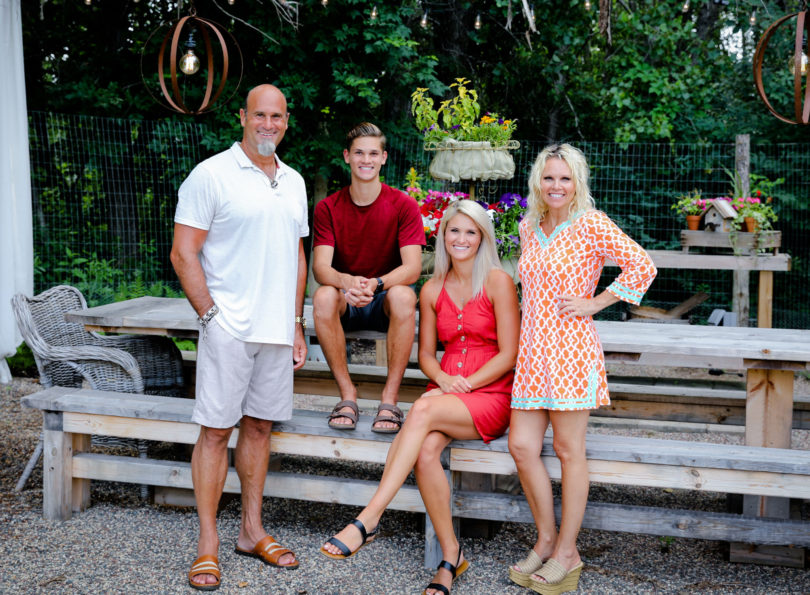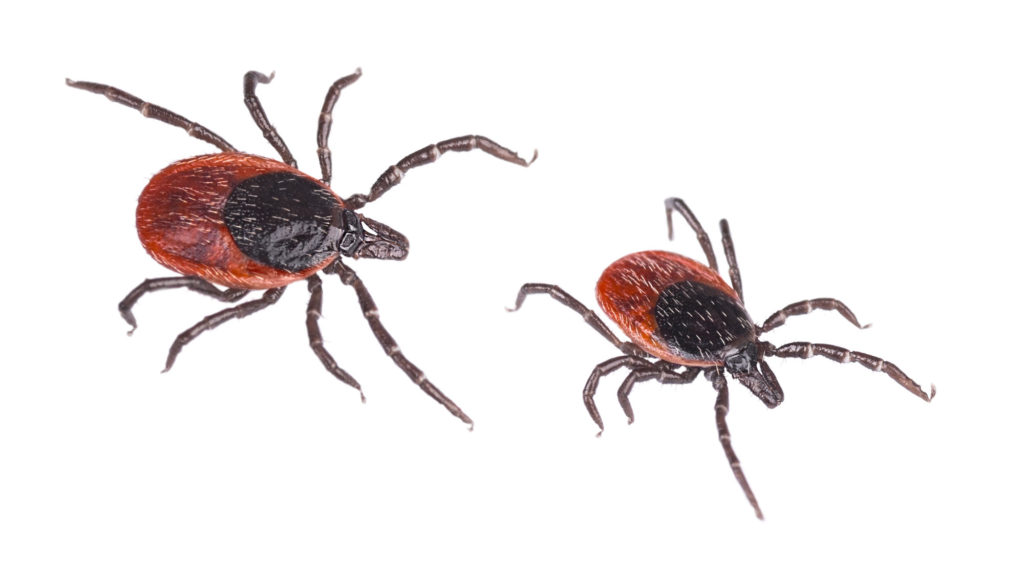Lisa Najarian has chronic Lyme disease, and every day is a test of her mettle.
Now 52, she estimates she’s had Lyme — a disease for which there is no cure — for 20 years. On any given day, she struggles with various debilitating symptoms, frequently multiple ones at once. It’s been a long and daunting journey, and if she preferred to now focus only on herself, on simply making the best of each challenging day, who would blame her?
Instead, Lisa has chosen a positive, proactive path to help others avoid the fate that befell her. The daughter-in-law of internationally known transplant pioneer Dr. John Najarian, Lisa is a resident of the Twin Cities in Minnesota — a region that’s No. 2 among the nation’s hot spots for Lyme infection — and in July 2018 she and her husband Pete launched the Twin Cities Lyme Foundation.
Lisa serves as executive director, and Pete, a CNBC commentator and former pro football player, is the foundation’s chief financial officer. Together they aim to raise awareness of Lyme disease and help potential Lyme patients obtain the correct diagnosis. Lisa herself waited 16 years to get confirmation.
“I Think It’s in Your Head”
Lyme disease, first identified in Connecticut in 1975, is caused by the bacterium Borrelia burgdorferi. There are 300 strains of Lyme globally, and more than 100 are found in the United States. Humans can become infected with Lyme after being bitten by an infected blacklegged tick, also known as a deer tick. Lyme disease has been recorded in all 50 states, with the most cases in East Coast states from Virginia north to Maine. The classic manifestation of an early, localized infection is an outwardly expanding rash called an erythema migrans — popularly known as a bull’s-eye rash.
Lisa’s first symptom turned up in 1999, when she awoke one day and couldn’t hear out of her left ear. She has no memory of a tick bite, or of any appearance of the bull’s-eye rash, but she was an avid gardener at the time. She didn’t know then what Lyme disease was or what symptoms it could initially cause.
Over time she developed other symptoms, including heart palpitations, vertigo, migraines and arthritis. She spent years visiting specialists as each new symptom appeared — an ear-nose-throat specialist (ENT), a cardiologist, a neurologist, a rheumatologist. At one point she even got a Lyme blood test, but it came out negative. She later learned that many people with Lyme get a negative test result because the bacteria lie dormant in their bodies, but they respond to antibiotics in a way that indicates Lyme. Not until 2015 did Lisa receive her diagnosis.
“It was not uncommon for a doctor to simply say, ‘I think it’s in your head,’” she says of her years searching for answers.
It Affects the Whole Family
Pete Najarian has seen firsthand — along with their daughter Lex, age 25, and son Kole, age 21 — how life-changing a chronic Lyme disease diagnosis can be.
“It affects the whole family,” he says frankly, “and it changed [Lisa’s] ability to do a lot of things at home. It changed the dynamic in the house.” He remembers how, at one point, she was bedridden for weeks at a time.
Lisa’s taken three rounds of antibiotics since her diagnosis, and she could be taking multiple medications for her many symptoms, but she says emphatically, “I’m trying not to take everything!” She still cannot hear out of her left ear.
And just recently, she’s changed her approach. Her latest treatment regimen — nine months of taking two weeks of the antibiotic Tetracycline, then two weeks off, to attempt to kill the Lyme bacteria — “really ruined my gut,” Lisa says. “It was bittersweet, because it was killing the bacteria, but I felt so sick.”
In light of that, she’s halted any treatment for now, determined to regain her equilibrium with a comparatively simple approach focused on exercise, healthy eating and trying to stay stress-free. While achieving that “stress-free” goal can be challenging under her circumstances, she does the best she can, focusing on positive efforts with her foundation.
Helping Patients Find Lyme-Literate Doctors
The foundation’s website (twincitieslyme.org) enables Twin Cities’ residents to assess their risk for Lyme and helps connect them to local doctors certified by ILADS, the International Lyme and Associated Diseases Society. Fundraising also helps provide grants for patients seeing those doctors. ILADS, based in Chevy Chase, Md., and founded in 1999, trains doctors to be “Lyme-literate,” as Lisa says, to accurately diagnose a disease with a huge range of symptoms that can be constantly changing over time. A certification by ILADS is regarded as the gold standard for physicians aspiring to correctly diagnose Lyme disease.
Dr. Jonathan Otten, a naturopathic physician in the Twin Cities who specializes in complex illness, has received patients through the foundation’s website, and now patients with tick-borne illnesses make up more than half his practice. Diagnosing Lyme is tricky, he says, because despite the assumption of many doctors, it relies chiefly on clinical diagnosis — a physical exam and medical history — rather than a blood test.
“I can see why well-intentioned physicians might send patients to specialists,” he says, “but the specialists aren’t really trained [to look for symptoms of Lyme disease], or they may simply think, ‘We’ve got a test for this.’ ”
But current Lyme testing is very poor, Otten says, estimated to miss about half of the actual cases because the bacteria lie dormant. Lyme is also a great imitator, appearing under the microscope like many other diseases such as multiple sclerosis, fibromyalgia and ALS (Lou Gehrig’s disease).
Equally problematic is that Lyme symptoms are unique in each patient, according to Otten, because there are so many strains of the bacterium that cause Lyme and so many different tick-borne co-infections that can appear alongside it.
Lyme Cases on the Rise
Otten believes chronic Lyme disease is greatly underdiagnosed, and adds that, though doctors aren’t sure why, the bacteria seem to increasingly evade initial antibiotics. So diagnoses are on the rise.
Roughly 300,000 new cases are diagnosed every year — making Lyme more common than breast cancer, HIV and Hepatitis C — but estimates are that there could actually be over 600,000 cases identified every year if detection was better.
Oddly enough, Pete Najarian says, more and more children are being diagnosed with Lyme, and the majority of those cases are children who got it in utero from parents who didn’t know they had it.
“People are very unaware of how prevalent Lyme is,” Pete says. “My wife’s been really in front of it, trying to get that message out.” Pete and Lisa hope to wield their impact beyond Minnesota as fundraising allows.
Otten emphasizes that Lyme is an issue all over the world. “It’s got to be on your radar.”
Tips for Prevention
- Use chemical or natural repellents whenever you are outdoors.
- Avoid particular habitats, such as long grass, where ticks may hide.
- After outside activity, finish your day with a shower using a scrub-type cloth. This helps to slough off any clinging ticks before they become embedded.
- Some ticks can be as tiny as a speck of pepper, so be diligent when checking yourself or examining others.
- If a tick bites you, watch for the appearance of the bull’s eye rash, an outwardly expanding rash that indicates early Lyme infection. Note, however, that there are many atypical rash variations, and the majority of patients with Lyme disease have no recollection of a rash. Rashes may feel warm, but are typically painless. Often, early on, infected individuals will also experience flu-like symptoms including fever, chills, fatigue and muscle aches.
- If you suspect you may have Lyme, and especially if you know you’ve been bitten by a tick, find a Lyme-literate practitioner in your area, as they are experienced and educated by the International Lyme and Associated Diseases Society (ILADS, at www.ilads.org). Lyme disease is most easily treated in the very early days of the infection. If left untreated, the infection can turn into chronic lyme disease and can spread to joints, the heart and the nervous system.




